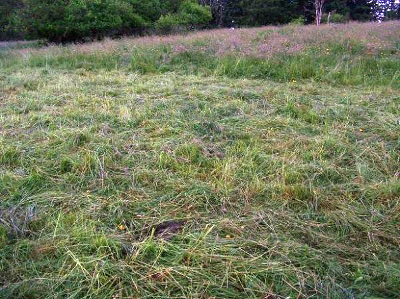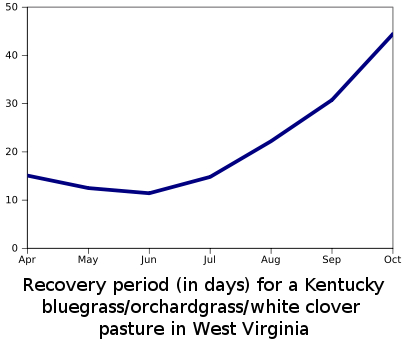
Pasture occupation and recovery periods
 One of the tricky parts of
rotational grazing is figuring out how long to let your livestock stay
in a paddock (the occupation period) and how long they need to be
somewhere else before they can come back (the recovery period.)
If you get the recovery period wrong, you may end up with only a third
as much forage from your pasture, and if you get the occupation period
wrong, your pasture will be dominated by unpalatable plants.
One of the tricky parts of
rotational grazing is figuring out how long to let your livestock stay
in a paddock (the occupation period) and how long they need to be
somewhere else before they can come back (the recovery period.)
If you get the recovery period wrong, you may end up with only a third
as much forage from your pasture, and if you get the occupation period
wrong, your pasture will be dominated by unpalatable plants.
The occupation period
will depend on how many animals you have in the paddock --- fifty
chickens will eat the grass down to 2 inches faster than five chickens
will. In a perfect world, you should graze small enough areas
that the occupation period is only a day or two long, but up to six
days is okay. Occupation periods over six days are problematic
since your animals will start to be selective about what they eat and
will graze new growth, which eventually makes the plants your animals
don't like take over the pasture.
 The recovery period depends
on the season. Lush spring pasture may grow fast enough that it's
ready to be grazed again in two weeks, but the cool season grasses in
most of our pastures slow down as summer sets in. This graph
shows the recovery period for an intensively grazed pasture in West
Virginia, with recovery periods ranging from a low of 11 days in June
to a high of 44 days in October.
The recovery period depends
on the season. Lush spring pasture may grow fast enough that it's
ready to be grazed again in two weeks, but the cool season grasses in
most of our pastures slow down as summer sets in. This graph
shows the recovery period for an intensively grazed pasture in West
Virginia, with recovery periods ranging from a low of 11 days in June
to a high of 44 days in October.
Bill Murphy stresses the
point that you have to learn your own pastures and not depend on his
facts and figures. The best way to determine the proper
occupation and recovery period is to keep an eye on pasture growth
every day. When the grass has grown up to three or four inches
tall, move your chickens in. When they've eaten it down to one or
two inches, move them out. That way you won't end up with the
pasture problems I'll discuss in tomorrow's post.
| This post is part of our Greener Pastures on Your Side of the Fence
lunchtime series.
Read all of the entries: |
Want more in-depth information? Browse through our books.
Or explore more posts by date or by subject.
About us: Anna Hess and Mark Hamilton spent over a decade living self-sufficiently in the mountains of Virginia before moving north to start over from scratch in the foothills of Ohio. They've experimented with permaculture, no-till gardening, trailersteading, home-based microbusinesses and much more, writing about their adventures in both blogs and books.
Want to be notified when new comments are posted on this page? Click on the RSS button after you add a comment to subscribe to the comment feed, or simply check the box beside "email replies to me" while writing your comment.
